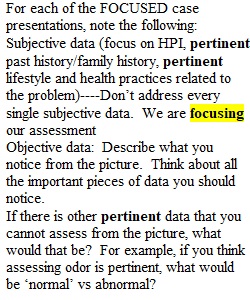


Q The following groups will address the corresponding Cases Download Casesfor our FOCUSED Assessment 1. For each of the FOCUSED case presentations, note the following: 1. Subjective data (focus on HPI, pertinent past history/family history, pertinent lifestyle and health practices related to the problem)----Don’t address every single subjective data. We are focusing our assessment 2. Objective data: Describe what you notice from the picture. Think about all the important pieces of data you should notice. 3. If there is other pertinent data that you cannot assess from the picture, what would that be? For example, if you think assessing odor is pertinent, what would be ‘normal’ vs abnormal? • Groups 1, 2 and 9: Case #1 • Groups 3 and 4: Case #2 • Groups 5 and 6: Case #3 • Groups 7 and 8: Case #4 ADDITIONAL QUESTIONS • Group 1 and 9: Q 1-3 • Group 2: Q 4-6 • Group 3: Q 7-9 • Group 4: Q 10-12 • Group 5: Q 13-15 • Group 6: Q 16-18 • Group 7: Q 19-21 • Group 8: Q 22-24 1. How would you describe this? What characteristics do you notice? 2. How would you describe this ruptured bulla (blister)? Is this a primary lesion or secondary lesion? Why? 3. What are examples of secondary lesions? 4. What do you notice here? 5. Describe what you notice here: 6. What assessment finding would lead the nurse to auscultate the thyroid? How would you do this? 7. What is the provider assessing here? What specific data is the nurse collecting? 8. How would you describe this assessment finding? What is the potential cause? 9. What lymph nodes are the nurse assessing? What specific data is the nurse collecting? 10. What lymph nodes are the nurse assessing? What specific data is the nurse collecting? 11. How would you perform the confrontation test? What is the purpose? 12. How would you perform assessment for accommodation of the eyes? What is the purpose? 13. What data can you collect by pulling the eyelid down like this? What specific data is the nurse collecting and how would you interpret these findings from this picture? 14. What do you notice here? How would you interpret this assessment finding? 15. How do you assess consensual pupillary response? What does that look like? What is 'normal' finding? 16. How would you describe this assessment finding? What could be the cause? 17. What would be a question you could ask to obtain subjective data for the mouth that focuses on lifestyle and health practices? 18. How would you inspect the buccal mucosa? What specific data would you collect? 19. How would you describe this assessment finding? What may cause this? 20. How would you interpret this finding? 21. How would you interpret this finding? 22. How would you interpret this data? (You noticed this after you gently pinched the skin under the clavicle) 23. How would you describe this? How would you interpret this data? 24. How would you describe this? How would you interpret this data? PreviousNext
View Related Questions